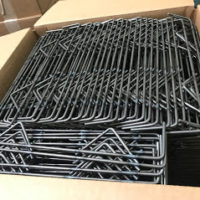
Installing Rebar Positioners for Masons
Masonry contractors have the experience of using rebar positioners for many years. Although vertical positioners don’t necessarily add structural value to the wall, they are a great help to the mason contractors as they assist in positioning the bars in the center of the core to ensure the lapping process is not complicated. Some of the most common rebar positioners in use are the O ring, S type, and Figure 8. They use wire loops in the center to block the crossing of the core as the mason contractor installs the perpendicular to the block. Although the installation process is easy for some, many still have questions on positioning the rebar. How to Install Rebar Positioners is set forth herein, and here are some of the questions are discussed below:

- What should the ideal distance of the positioners be while installing?
Ans: Vertical spacing of the positioners is usually set four feet from each other. The mason contractor will need a bed joint where he will set the mortar to increase the stability of the unit. As the rebar positioners for masons are four feet apart, it gives them the appropriate balance to stay vertical on the bed joint. There are different placement tolerances for different rebar applications. The masonry contractor needs to go through the Specification for Masonry Structures to find out the exact tolerance for the structure he is dealing with.
- Is there a specific measurement to determine the distance from the center point?
Ans: Those who want to install perpendicular blocks will have to work from the center of the core. You can use the center point and an additional 0.5-inch width to adjust the unit. Alternatively, you can use the wall thickness and an extra 2 inches along the wall’s length. This gives you space to a 1:4 ratio from the core center to the length of the wall. It is the ideal code compliance design that you need for vertical applications.
- Is it okay to install rebar positioners manually?
Ans: Some masonry contractors prefer to install vertical bar positioners manually. However, you should not follow that process because often, it does not meet the compliance code and you will be in trouble after the construction is complete. The use of rebar positioners for masons reduces the margin of error that you may commit while following the compliance codes. Also, manual installation is not safe as the unit moves while you install. The resultant structure may crumble down if the positioners are not installed correctly. In most cases, the top shelf is mis-balanced when you try to center the positioners at the base to offer more support.

- How to ensure that the unit doesn’t move while installing the rebar positioned?
Ans: Sometimes the top shelf of the unit tends to move while installing the rebar positioners. You can avoid this by using core inserted positioners. These are designed to cross the center of the core diagonally allowing it to fit all the corners tightly to the core. Since these are core positioners, they will position the bars according to the compliance code. You can mark the code compliance zone before starting the installation process. This helps to place the bars in that exact area so that they fit tight and don’t allow the unit to move.
You will also find a safety bend in the form of a tail section that extends outside the wall to indicate the masonry contractor to turn it in the opposite direction if the positioning is going wrong. Recent modifications with rebar positioners for masons have also seen the use of double vertical core positioners. However, their design is different from the traditional rebar positioners. But if you want to follow the conventional method, make sure you follow the steps above.
To learn more about rebar positioners or to buy our products click here. Find our products page here.
To learn about our company check us out here.


